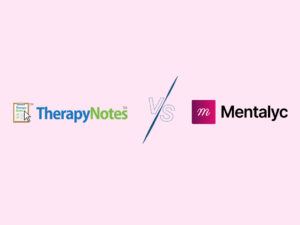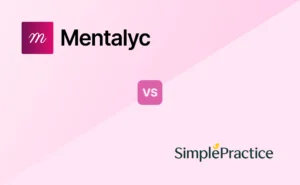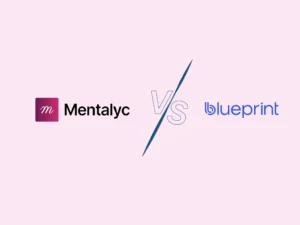Mental health professionals use DARP notes to record what happens during a client’s session. These notes keep track of key details that support the client’s care. DARP stands for Data, Assessment, Response, and Plan. This DARP format helps mental health practitioners organize their notes in a clear way. It is also useful for legal records and billing.
This article will explain how DARP notes work with examples. Therapists can learn how to properly document clinical notes using the DARP format.
What Does DARP Stand For?
D – Data
This section includes facts from the session. It combines two things: what the client says and what the therapist sees.
- Subjective data is what the client shares. This includes their feelings, symptoms, or life events. The therapist can write this using the client’s own words. For example: “I’ve been feeling really down.”
- Objective data is what the therapist observes. This includes things like crying, body posture, or eye contact. For example: The client cried for five minutes and avoided eye contact.
This part should not include the therapist’s opinion. It only reports what was said and what was seen. Instead of saying, “The client felt really sad,” write, “The client said he felt very down and cried during the session.”
A – Assessment
This part is the therapist’s view of what the data means. It shows how the client is doing. The therapist looks at the client’s progress, problems, or patterns. The therapist can connect what occurred during the session to the goals of the session.
For instance, if the client cried during the session, the therapist might write- “The client seemed emotionally distressed. This may be due to his recent job loss. It is affecting his focus and daily routine.”
This section explains what the therapist thinks is going on based on what was said and seen.
R – Response
This part shows how the client reacted during the session. It includes their response to the topic, questions, or interventions used. It also shows if they understood or agreed with the session. The therapist can note any changes in behavior.
For example, after teaching a breathing exercise, you might write- “Client said he felt a little calm after using the technique.”
Or, if you challenged a negative thought- “Client first disagreed, but later said he could see a different point of view.”
This section helps track how the client is responding to the therapy being done.
P – Plan
This part shows what will happen next. It lists the therapist’s next steps and the client’s tasks. The plan should match the client’s treatment goals.
It may include the next session’s focus, homework, or new skills to learn. It can also mention referrals or changes in medication.
For example: “Client will practice breathing daily. Next session will focus on managing stress at work.”
This section helps guide future sessions and keeps the therapy on track.
When to Use DARP Notes
DARP notes can be used in different mental healthcare settings because of their flexibility.
Mental Health Settings
Therapists use DARP notes to keep track of progress during individual, family, or group sessions. They can also be used for a wide range of mental health issues like depression, anxiety, or schizophrenia.
Case Management
Case managers use DARP notes to document interactions with various clients. It captures information such as the client’s needs, resources provided, and any barriers to accessing mental health services.
Treatment for Substance Use
DARP notes can be used in recovery programs like addiction. It helps therapists keep track of a client’s recovery journey. It records details like triggers, cravings, coping skills, and progress in the journey to recovery.
School Counseling
DARP notes can be used by counselors in schools to track student behaviors, academic challenges, and support provided.
Medical Settings
The DARP is also used in general medical services to document doctor-patient interactions and care plans.
Rehabilitation Services
DARP notes are used in rehabilitation centers like physiotherapy, occupational therapies, and speech therapies. They are used to document a patient’s progress in therapy along with how they’ve responded.
Comparison with SOAP, BIRP, and Other Note Formats
The DARP is one way to write clinical notes. There are several others, each with a structure that is slightly different.
SOAP Notes
The SOAP is a common format. Its acronyms stand for Subjective, Objective, Assessment, and Plan.
S – Subjective: This is what the client tells the therapist (i.e. their history, feelings, symptoms). This is very similar to some aspects of the DARP’s “Data”.
O – Objective: This is what the therapist observed during the session. This is also similar to the “Data” section of the DARP.
A – Assessment: This is the therapist’s clinical interpretation of the subjective and objective information. This is also similar to DARP’s “Assessment”.
P – Plan: These are the next steps the therapist intends to take (i.e. interventions or strategies). This is very identical to DARP’s “Plan”.
Main Difference: While the SOAP note format separates the subjective and objective data, the DARP combines these into the “Data” section. Apart from this, the DARP has a “Response” section. But the SOAP note combines this into the “Assessment” or “Plan”.
BIRP Notes
This format stands for Behavior, Intervention, Response, and Plan.
B – Behavior: This captures what the client did or said. It is quite similar to the DARP’s “Data.”
I – Intervention: This is what the therapist did during the session. The “Intervention” section documents the approach or strategies the therapist applied to provide the client support.
R – Response: This covers how the client reacted to the intervention. It is very much identical to DARP’s “Response” Section.
P – Plan: This talks about the next steps the therapist intends to take to ensure continued care. It is also similar to the DARP’s “Plan.”
Main Difference: BIRP specifically separates “Intervention” as its own section, while DARP’s “Assessment” briefly mentions interventions or they might be implied within the “Response.”
Progress Notes (General)
Many therapists and clinics just use a general “progress note” format. In these notes, you might see headings like “Session Summary,” “Client Progress,” and “Recommendations.” However, these general progress notes are less structured than DARP, SOAP, or BIRP. Therapists can write in a way that fits the session. But it may not follow a set order like other note formats do.
Main Difference
The DARP, SOAP, and BIRP all provide a standard and structured approach to writing clinical notes. This can be quite helpful for therapists who aim to be consistent. They also ensure that all important elements are covered within the clinical notes.
Many therapists prefer using DARP due to the “Response” section. It shows how the client reacted to the therapist’s actions. This helps the therapist know if the intervention was helpful.
How to Write DARP Notes (Step-by-Step)
Writing DARP notes can be quite simple, once you understand how it works.
Writing Objective Data
Start with the Data section. This part should include only facts. Here are some tips to guide your writing:
- Be Specific Don’t write: “The client appeared angry.” Instead, write: “The client said he felt ‘very furious’ since yesterday. He clenched his fists while talking about his wife.”
- Use Quotes Use the client’s exact words when it helps give meaning. Quotes help keep the full context. For example: “Client said he feels ‘not good enough’ most times.”
- Observe Behaviors Write down what you see. This includes how the client acts, speaks, or moves. Example: “Client fidgeted with hands during the session.” “Client made steady eye contact throughout.”
- Include Relevant History If the client shares new facts that relate to their goals, include them. This helps show what matters to the client now.
- Focus on the Current Session Write what happened in the session. If there are clear changes, note them. For example: “Client was quiet in early sessions but now shares more freely. He now trusts the process more.”
Making a Clinical Assessment
After writing the Data section, the next step is the Assessment. This is where the therapist looks at what the data means.
- Interpret the Data Look at what the client said and did. Then ask: What does this show? Example: “Client’s tiredness and trouble getting out of bed match symptoms of depression.”
- Link it to Therapy Goals Think about how the session connects to the client’s goals. Example: “Client’s morning struggle affects his goal to increase daily activity.”
- Look for Repeating Patterns Notice if the same issues come up often. Example: “Client still finds it hard to manage strong emotions.”
- Make a Hypothesis This is your idea about what may be going on. Example: “Client may feel hopeless about her money problems.”
- Note Progress or Lack of It Say whether things are improving or not. Examples: “Client is slowly learning to spot her anxiety triggers.” “Client seems unwilling to talk about past trauma.”
Documenting Client’s Response
The Response section shows how the client reacted during the session. It includes how they responded to activities, questions, or interventions.
- Specific Reactions Write what the client did or said in response. Example: “Client nodded when we talked about setting boundaries.” “Client was quiet at first but spoke more after feeling heard.”
- Mood or Behavior Changes Record any changes the client shared or showed. Example: “Client said anxiety dropped from 8/10 to 5/10 after relaxation.” “Client said she felt ‘a bit light’ after talking about her stress.”
- Level of Engagement Say how involved the client was in the session. Example: “Client joined fully in the role-play exercise.” “Client was quiet and gave short answers.”
- Client Understanding Write if the client understood the topic or not. Example: “Client said he understands how thoughts affect feelings.” “Client seemed confused about the homework.”
Planning Next Steps or Interventions
The Plan is the last part of the note. It shows what the therapist and client will do next. It should match the client’s treatment goals.
- Focus of Future Sessions Write what the next session will cover. Example: “Next session will focus on stress coping skills.”
- Client Homework or Tasks Include any assignments or activities the client should do. Examples: “Client will journal thoughts and feelings daily.” “Client will look into local caregiver support groups.”
- Planned Interventions Say what tools or approaches you will continue or introduce. Examples: “Will keep using CBT to challenge negative thoughts.” “May explore EMDR if client is ready.”
- Referrals Mention if you referred the client to another provider. Example: “Client was referred to a psychiatrist for evaluation.”
- Session Frequency Note how often sessions will continue. Examples: “Client will attend weekly sessions.” “Next session is in two weeks.”
DARP Note Example for Individual Therapy
Patient Name: Susan Connel Age: 35 Years
Gender: Female Date of Birth: May 22, 1990
D – Data: Client is a 35-year-old woman who appeared tired with a slumped posture and reduced eye contact. She stated that she had difficulty sleeping for the past week, sometimes getting only three hours of sleep at night. She said she had a fight with her sister two days ago and had been feeling “overwhelmed” ever since. She also reported feeling stressed about job security and finding it hard to concentrate on everyday tasks. At the beginning of the session, she gave her level of anxiety a rating of 7 out of 10.
A – Assessment: The client’s sleep problems, increased anxiety, and inability to focus appear to be related to the fight with her sister. She seems to have trouble handling conflict in a healthy way. These issues are affecting her daily life and mental well-being. She is trying to improve by learning better ways to talk and manage her emotions.
R – Response: She seemed withdrawn at first but began to open up when discussing how the fight had affected her sleep and anxiety. She appeared to have liked having her sense of overwhelm validated. I led her through a breathing exercise. Afterward, she said her anxiety dropped from 7 to 5. She realized the conflict made her feel worse and acknowledged that she needs to work on improving her sleep habits.
P – Plan:
- Continue building her skills in communication and conflict resolution.
- Client will practice deep breathing for 5–10 minutes each night. She will track her sleep in a diary.
- Next session will focus on setting healthy boundaries with her family.
- We will review her sleep and anxiety in the next session.
- If her sleep does not improve in two weeks, she will be referred to a sleep specialist.
- Next session is set for 25th June 2024 at 10:00 am.
DARP Note Example for Social Work
Here’s an example of how to write a DARP note in the context of social work. This is for a client who is looking to access resources in the community.
Patient Name: Morrison Kelvin Age: 62 Years
Gender: Male Date of Birth: March 14, 1963
D – Data: Client is a 62-year-old male who came to the Community Center for help with housing and food. He said he was evicted after being unable to pay rent. He has stayed at a temporary shelter for the past three days. He shared, “I was laid off from my job two months ago and haven’t found anything solid since then.”
He looked overwhelmed and wore wrinkled clothes. He said he had not eaten a full meal in over 24 hours. He carried a small backpack with his belongings.
A – Assessment: Client is facing urgent needs due to being homeless and without food. These issues are related to losing his job and his housing. His emotional stress is tied to his current living situation. He is open to help but feels overwhelmed by the process. His work history is unstable, and he has little support. These may affect his long-term recovery.
R – Response: The client was appreciative of the warm meal provided at the center. He seemed more relaxed after learning about shelters and food banks. The client assisted in completing the housing intake form and asked questions in regard to the process. He was eager to learn about job search assistance programs and was relieved to discover such options existed. He said his biggest need now is to find a place to stay.
P – Plan:
- Gave client a list of shelters and food banks with contact details.
- Helped him apply for emergency housing. He will follow up within 24 hours.
- Shared job program contacts and referred him to career services for an appointment.
- Booked a follow-up session for 20 August 2025 at 10:00 am to check progress and discuss long-term needs.
- Linked him with a volunteer to go with him to the nearby food bank.
- Will check on his mental health at the next visit due to visible stress and recent life changes.
Tips for Writing Effective DARP Notes
An effective DARP note should be;
Be Clear, Short, and Clinically Useful:
- Clear- Write in plain, easy-to-read language. Avoid lengthy or complex sentences. Consider how someone else might read your notes – would they be able to understand it?
- Short- Go straight to the point without including extra unnecessary words. Each sentence should add value to the note.
- Clinically Useful- Write only what helps explain the client’s progress, challenges, or treatment. Leave out small talk or personal opinions. If it doesn’t help the client’s care, don’t include it.
Avoid Jargon and Subjectivity
- No Jargon- Jargon refers to special words or expressions used by a profession or group. Though some clinical terms are needed. But don’t use overly technical language that someone outside your field might not be familiar with. If you need to use a technical term, describe it briefly if necessary.
- Don’t Be Subjective- Subjectivity is when you write based on what you personally think or feel. For instance, writing “Client was annoying today” is subjective. Instead, articulate the behavior objectively. “Client interrupted often and had trouble staying on topic.” State the facts in the “Data” section. In the “Assessment,” you’re making a professional judgment, but it should be related to the data, not solely your opinions.
Maintain Confidentiality and Compliance
- Confidentiality: Client information should always be kept confidential. Document only that data which is relevant to the client’s care. Keep notes private and controlled by individuals authorized to use the note.
- Compliance: This is how well the rules are followed. In the world of health care, this tends to mean regulations like the Health Insurance Portability and Accountability Act (HIPAA), which protects client privacy in the United States. In order to meet legal and ethical obligations, clinical notes must be accurate, timely, and thorough. Sign your notes and put the date on them.
Common Mistakes to Avoid
Even experienced professionals make errors in their notes. But knowing about these mistakes helps a professional to avoid them:
Mixing Up Sections
One of the biggest mistakes is putting information in the wrong section.
- “Data” in “Assessment”: Do not input raw observations (data) in your assessment. The “Assessment” is for your interpretation of the data.
- “Assessment” in “Data”: In the data section don’t include your opinions on the data or interpretation. Keep the data strictly based on facts.
- Response in Data/Assessment: The data you write should be the objective information related to what occurred, and what your client is shown to do. This may sound simple, but it takes practice to keep the parts separate. Go through and verify that everything written down in the note is correct.
Overloading with Unnecessary Details
You may want to be thorough but do not need to write everything that happened or was said in a session. Concentrate on the highlights and clinically relevant aspects. Too much detail can be distracting and difficult to read. For instance, there’s no need to explain the specific way a client walked into the room unless it is for clinical reasons. For instance, “Client walked in with a limp which favored his right leg”. Keep your notes focused and helpful.
Writing without a Clear Clinical Focus
Each DARP note should serve a specific purpose which is to report a client’s progress and plan of care. Notes with topics that do not seem to have a specific link to the client’s treatment goals, or the session goals, are not very useful. Before writing, consider the most important themes of the session and how they relate to the client’s overall journey to wellness. Each part should be able to add up to the last so that your session gets told chronologically.
Conclusion
DARP notes are a powerful tool for healthcare professionals. They provide a clear, structured way to document client interactions, track progress, and ensure everyone involved in a client’s care is well-informed. Structured notes like DARP are vital because they improve client care, improve communication, and support legal and ethical standards.
The more DARP notes you write, the quicker and easier it will be for a smooth practice. You can seek counsel from a supervisor or a professional colleague when needed. Write your notes as soon as you can after the session, while the details are still fresh in your mind. You can also use tools like Mentalyc to document clinical sessions. Mentalyc is an AI note-taking tool that allows professionals to use note-taking formats like the DARP.
FAQs
Do DARP Notes Comply with HIPAA?
Yes, DARP notes can follow HIPAA rules if they are written and stored the right way. DARP is just a way to organize clinical notes. Whether the notes are HIPAA-compliant depends on how well they are handled.
Can DARP Notes Be Used for Insurance Documentation?
Yes, DARP notes can be used for insurance purposes. Insurance companies need notes to show why a client is getting care. DARP notes are clear and well-structured. They include all key parts: Data, Assessment, Response, and Plan. Most insurers focus on the Assessment and Plan sections. These parts explain the reason for treatment and the next steps.
How Long Should a DARP Note Be?
There is no fixed length for a DARP note. The length depends on how complex the session was and what the client needed. It is good to keep it short but clear while including all important information. For a regular 50-minute session, a DARP note is usually about half a page to one full page when typed.
References
Carepatron. (2024, November 17). DARP note template & example [Free PDF download]. Carepatron.
Efseroff, B., & Allia Team. (2025, May). DARP notes – Detailed documentation guide with template and examples. Allia Health.
Psylio Team. (2024). Your guide to effective DARP notes (with PDF template). Psylio.
Why other mental health professionals love Mentalyc

“It’s so quick and easy to do notes now … I used to stay late two hours to finish my notes. Now it’s a breeze.”
Licensed Professional Counselor

“By the end of the day, usually by the end of the session, I have my documentation done. I have a thorough, comprehensive note … It’s just saving me hours every week.”
CDCII

“A lot of my clients love the functionality where I can send them a summary of what we addressed during the session, and they find it very helpful and enlightening.”
Therapist

“It takes me less than 5 minutes to complete notes … it’s a huge time saver, a huge stress reliever.”
Licensed Marriage and Family Therapist







